Tubes and Tires 101
Tubes and tires are far more than doughnut shaped pieces of rubber, read on and become a tube and tire expert, then wow your customers with your style and saavy !
Clincher Tires
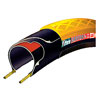
Conventional tires used on 99% of all bicycles are "clincher" type, also known as "wire-on." They consist of an outer tire with a u-shaped cross section, and a separate inner tube. The edges of the tire hook over the edges of the rim, and air pressure holds everything in place.
Many people suppose that tires are made out of rubber, because that's what is visible. This is a major oversimplification--rubber is the least important of the three components that make up a tire:
Bead
The "bead" is the edge of the tire. On most tires, the beads consist of hoops of strong steel wire. The beads are what holds the tire onto the rim, and are, in a sense, the "backbones" of a tire.
While most beads are steel, some tires use Kevlar ® cord instead. Using Kevlar ® for this purpose typically saves about 50 grams (2 ounces) per tire. Since Kevlar ® is much more flexible than steel, tires with Kevlar ® beads can be folded up compactly, which is convenient for touring or other applications where it may be advisable to carry a spare tire.
Fabric
Cloth fabric is woven between the two beads to form the body or "carcass" of the tire. This is the heart of the tire, the part that determines its shape. The vast majority of tires use nylon cord, though some use polyamide. Up until the 1960s, cotton/canvas was commonly used. Cotton and silk are still used for some tubulars.
The fabric threads don't interweave with crossing threads as with normal cloth, but are arranged in layers or "plies" of parallel threads. Each layer runs perpendicular to the next layer(s).
Some tires use thick thread, some use thin thread for the fabric. With thin thread, there are more threads per inch ("TPI") and this number is often considered an important indication of tire performance.
The higher the TPI number, the thinner and more flexible the tire fabric is. Thin-wall (high TPI) tires tend to be lighter and have lower rolling resistance, but they're more easily damaged by road hazards.
Bicycle tires have the threads of the fabric running diagonally, ("bias") from bead to bead. Modern car tires have the main threads running straight over from one bead to the other, known as "radial" construction. Radial tires will also have a "belt" of plies running all the way around the circumference of the tire, crossing the radial plies.
Radial tires have been tried for bicycles, but they tend to be too floppy from side to side. This floppiness feels quite unpleasant in actual riding--much like the feel of a grossly underinflated tire.
Some bicycle tires also have a Kevlar ® belt running under the tread area, in addition to the normal bias plies. This is intended as a puncture preventive.
Rubber
Once the fabric has been woven between the beads, and the tire has its basic shape, it is coated with rubber. The rubber is mainly there to protect the fabric from damage, and has no structural importance.
The rubber that comes into contact with the ground is called the "tread." This area usually has thicker rubber than the "sidewalls" of the tire, mainly for wear resistance. Most tires have some sort of 3-dimensional pattern moulded into the tread, which may or may not enhance traction.
Manufacturers mix different additives with the rubber to achieve desired traction/wear characteristics. Generally, a softer formulation will give better traction, but at the expense of more rapid wear. Rubber is normally a sort of tan color, but most tires are black. This is the result of adding carbon black to the mix. Carbon black considerably improves the durability and traction of the rubber in the tread area.
Some manufacturers substitute a silicon compound for the carbon black. These tires usually have a grey tread. Whether silicon or carbon black provides better traction is subject to dispute.
"Dual compound" tires feature a center strip of fairly hard rubber for improved wear, with a softer, grippier formulation toward the sides of the tread. The intent is to provide better cornering traction without compromising the lifespan of the tread.
Many bicycle tires are "gumwalls" or "skinwalls." Gumwall tires have tan sidewalls, with no carbon black. This may make the sidewalls slightly more flexible, reducing rolling resistance. It is not clear to what extent this makes a difference.
Skinwalls have either no rubber on the sidewalls, or a very thin layer. This, too is an attempt to make the sidewall more flexible and reduce rolling resistance.
Tubulars
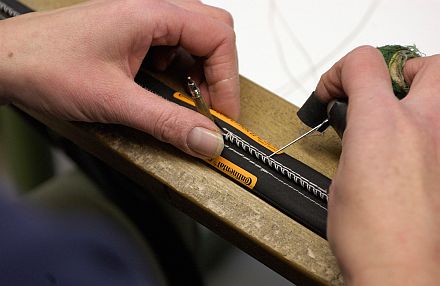
Ever wonder why they call them sew-ups ?
Tubular tires, also known as "sew-ups" or "sprints" differ from clinchers in that they don't have beads. Instead, the two edges of the tire are sewn together around the inner tube. Tubulars are used on special rims, and are held on to the rims by glue.
Tubulars used to be fairly common on high-performance bicycles, but these days they are an endangered species.
The Good:
Tubulars are a bit lighter than comparable clinchers, due to the absence of the beads. The development of Kevlar® beads has considerably reduced this advantage.
Tubular rims are lighter than clincher rims, since they don't need the flanges that hold the bead of the tire in place.
Tubulars are less prone to pinch flats than clinchers, since the rims don't present the sharp edges of the clincher flanges.
Many riders believe that tubulars provide a more comfortable ride and better traction than clinchers.
If you get a flat on a tubular, you can install a spare tubular faster than you can change an inner tube in a clincher.
The Bad:
Tubulars are considerably more expensive than clinchers of comparable performance.
Tubulars are very much harder to repair once punctured. Most people just throw them away.
You need to carry a complete spare tubular in case you get a flat. This negates the weight advantage over clinchers, unless you have a team car following you with spare wheels.
If you replace a tubular on the road, you cannot corner safely at high speeds until you go home and re-glue the tire. For safe high-speed cornering, the glue needs to dry for at least several hours.
Tubulars have higher rolling resistance than the best clinchers.
Tubulars are rarely as true and round as clinchers.
Improperly glued tubulars can roll off the rim. This almost always causes a serious crash.
Tubes
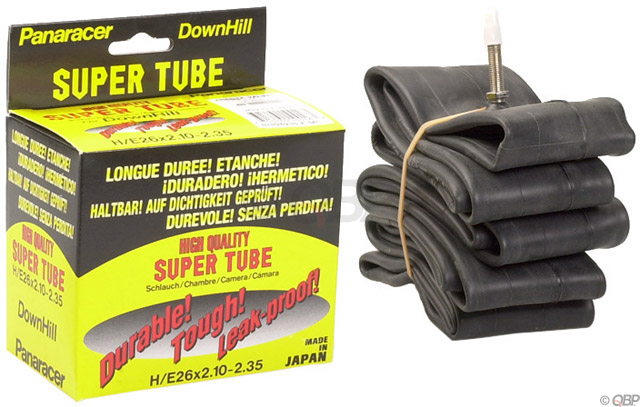
An inner tube is basically a doughnut-shaped balloon, with a valve for inflation. The only requirement for an inner tube is that it not leak. Being rubber, they have no rigid structure. If an inner tube is inflated outside of a tire, it will expand to 2 or 3 times its nominal size, if it doesn't explode first, as our service crew has demonstrated on ocassion. Without being surrounded by a tire, an inner tube can't withstand any significant air pressure.
Tubes we carry sport two distinct types of valves:
Schrader valve
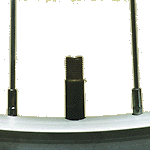
Sharder valves should always have a cap on, to avoid the contamination and malfunction of the spring loaded valve
Presta valve
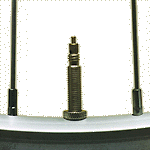
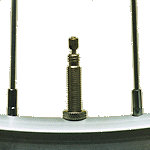
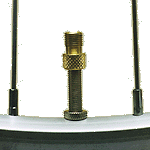
Closed Open Presta Adapter On (for inflation only)
Presta valves are the narrow valves used on most high-performance bicycles, and all tubulars, also known as a "French valve". Presta valves have built-in valve caps, which must be opened before you can pump them up. These caps are "captive" nuts, which cannot be removed. Since there is no spring in a Presta valve, this knurled nut must be retightened after inflating the tire, or the valve may leak slowly.
Presta valves are light, and don't require as large a hole in the rim. Since the don't use a spring, they can be easier to pump with a hand pump.
Butyl vs Latex
Before World War 2, tires and tubes were made from natural latex rubber, harvested from tropical trees. When the supply of natural latex was insecure during the war, a substitute, "butyl" was invented. Butyl turned out to be a very successful substitute, better, in fact, than latex for this application. All modern tires and most inner tubes use butyl rubber.
Some riders prefer latex inner tubes, because they can be a bit lighter than butyl ones. Some riders believe that latex tubes have less rolling resistance than butyl.
Latex tubes are commonly a bit more porous than butyl ones, and need to have their pressure topped off more often.
Traction, Pressure and Tread Patterns
Traction
"Traction" refers to the tire's resistance to skidding/slipping. There are three areas where traction is at issue: braking, climbing, and cornering. Different tire designs, particularly in the tread, may enhance or degrade traction in each of these dimensions.
The traction of a tire is determined by three things: inflation pressure, rubber formulation, and tread pattern.
Also keep in mind that inflation pressure is relative to the rider's weight, road or surface conditions, and all of these variables have an effect on traction.
Traction is also influenced by the presence or absence of suspension, and by the rider's posture and technique
Pressure
Most tires have a "maximum" pressure, or a recommended pressure range marked on the side of the tire. These pressure ratings are established by the tire manufacturers after consultation with the legal and marketing departments.
The legal department wants the number kept conservatively low, in case the tire gets mounted on a defective or otherwise loose fitting rim. They commonly shoot for half of the real blow-off pressure.
The marketing department wants the number high, because many tire purchasers make the (unreliable) assumption that the higher the pressure rating, the better the quality of the tire.
Newbies often take these arbitrary ratings as if they had some scientific basis. While you'll rarely get in trouble with this approach, you will usually not be getting the best possible performance with this rote approach.
Savvy cyclists experiment with different pressures, and often even vary the pressure for different surface conditions.
Optimal pressure for any given tire will depend on the load it is being asked to support. Thus, a heavier rider needs a higher pressure than a lighter rider, for identical tires.
Since most bicycles have substantially more weight on the rear wheel than on the front, the rear tire should almost always be inflated to a higher pressure than the front, typically by about 10%.
Rough surfaces generally call for a reduction in pressure to improve ride comfort and traction, but there is a risk of pinch flats if you go too far.
Rider skill also enters into this: more experienced cyclists learn to "get light" for a fraction of a second while going over rough patches; newbies tend to sit harder on the saddle, increasing the risk of pinch flats, not necessarily a bad thing, since this brings them back into the store... :-)
The table below should only be used as a very rough guide to a starting point, and to "illustrate" what is stated above, regarding the rider weight / inflation pressure relationship.
Wheel load
50 mm
37 mm
32 mm
28 mm
25 mm
23 mm
20 mm
100 lbs/50 kg
45
60
75
100
110
120
130
70 lbs/35 kg
35
50
65
80
90
100
110
Tread Patterns
The "Tread Pattern" is dictated by the external tri-dimensional design pattern of the tire. Tread patterns vary inmensly and in most cases it is the single most determining factor for rolling resistance and traction. Tread patterns are application specific, so before making any recomendation to a customer, you should make sure that the you understand what type and model of bicycle they are riding, as well as what surface and surface composition they will be riding on.
Knobby tires are designed to perform off road, in loose, muddy, rocky conditions, and are not intended to be used in hard paved surfaces, where they will squirm and wear out fast.
Knobby treads actually give worse traction on hard surfaces! This is because the knobs can bend under side loads, while a smooth tread cannot, the bending of knobs can cause discontinuities in handling; the tire grips OK for mild cornering, but as cornering force exceeds some critical value, the knobs start to bend and the traction suddenly goes out the window.
Slick or "bold" tires on the other hand are specifically designed to be used on hard surfaces, where they grip just fine due to the smooth continuos contact patch, and their stable and predictable carcass. The exact oposite applies if ridden in loose surfaces, due to the absence of soil penetrating knobs, bold tires will "wash out" slide and send you face and belly first, in the most embarassing and painful maner.
Combination Treads
Many tire makers market "combination tread" tires, that are purported to work well both on pavement and dirt. Generally, they don't.
The usual design is to have a smooth ridge down the center of the tread, with knobs on the sides. The theory is that the ridge will provide a smooth ride on pavement, with the tire inflated fairly hard, and the knobs will come into play off-road, with the tire running at lower pressure (or sinking into a soft surface.) Another aspect of this design is that the knobs are intended to come into play as you lean into a turn.
In practice, combination tread tires don't work all that well. They do OK in dirt, but they're pretty lousy on pavement. They're much heavier than street tires, and if you corner aggressively, the transition from the center strip to the knobs can cause sudden washout. They aren't quite as slow and buzzy as true dirt tires, but they're much worse in this respect than smoothies.
If you mostly ride on pavement, but also do a fair amount of dirt, a combination tire on the front may be a good choice for you, with a road or "slick" tire on the back.
Sizing
Tire sizing, although usually straight forward and rather self explanatory, can sometimes be tricky and several factors must be considered.
Bicycle tires come in a bewildering variety of sizes. To make matters worse, in the early days of cycling, every country that manufactured bicycles developed its own system of marking the sizes, these different national sizing schemes created a situation in which the same size tire would be known by different numbers in different countries, even worse, different-sized tires that were not interchangeable with one another were often marked with the same numbers...
So how does this free spirited manufacturing approach affect us today? well anytime you are helping a customer find and select tires that are suitable and compatible for their bicycle, you must remember this confounded legacy, and ask away:
- What kind of bicycle is this going on?
- What brand and year is this bicycle?
- Does it continue to have the stock wheelset, or have the wheels been changed / up dated?
- What kind of riding is the customer going to be doing, and on what surfaces?
- How much does your customer weigh?
Sizing is determined by these and perhaps a few other factors. Now let's look at some charts that should help clarify the main diferences for each distinct sizing approach:
NOTE: If two tires are marked with sizes that are mathematically equal, but one is expressed as a decimal and the other as a fraction, these two tires will not be interchangeable.
Fractional sizes:
| Fractional | ISO | Applications |
|---|---|---|
| 29 inch | 622 mm | This is a marketing term for wide 622 mm ("700c") tires. |
| 28 x 1 1/2 | 635 mm | English, Dutch, Chinese, Indian Rod-brake roadsters (Also marked F10, F25, 700 B) |
| 622 mm | (F.13)Rare Canadian designation for the (F.13) | |
| 28 x 1 5/8 x 1 1/4 | Northern European designation for the 622 mm (700 C) size | |
| 27 x anything | 630 mm | Older road bikes |
| 26 x 1 (650 C) | 571 mm | Triathlon, time trial, small road bikes |
| 26 x 1 1/4 | 597 mm | Older British sport & club bikes |
| 26 x 1 3/8 (S-6) | 597 mm | Schwinn "lightweights" |
| 26 x 1 3/8 (E.A.3) | 590 mm | Most 3-speeds, department-store or juvenile 10 speeds |
| 26 x 1 1/2 (650B) | 584 mm | French utility, tandem and loaded-touring bikes, a very few Raleigh (U.S.) & Schwinn mountain bikes. |
| 26 x 1 3/4 (S-7) | 571 mm | Schwinn cruisers |
| 24 x 1 | 520 mm | High performance wheels for smaller riders; Terry front |
| 24 x 1 1/8 | 520 mm or 540 mm! | Continues to be a mystery |
| 24 x 1 1/4 | 547 mm | British or Schwinn Juvenile |
| 24 x 1 3/8 (S-5) | 547 mm | Schwinn Juvenile lightweights |
| 24 x 1 3/8 (E-5) | 540 mm | British Juvenile, most wheelchairs |
| 20 x 1 1/8 20 x 1 1/4 20 x 1 3/8 | 451 mm | Juvenile lightweights, BMX for light riders, some recumbents |
| 20 x 1 3/4 | 419 mm | Schwinn juvenile |
| 17 x 1 1/4 | 369 mm | Alex Moulton |
| 16 x 1 3/8 | 349 mm | Older Moulton, Brompton & other folders, Recumbent front, juvenile |
| 16 x 1 3/8 | 337 mm | Mystery tire |
| 16 x 1 3/8 | 335 mm | Polish juvenile |
| 16 x 1 3/4 | 317 mm | Schwinn Juvenile |
| 12 1/2 x anything | 203 mm | Juvenile, scooters |
| 10 x 2 | 152 mm | Wheelchair |
| 8 x 1 1/4 | 137 mm | Wheelchair |
High-performance sizes (571 mm /26 x 1 & 630 mm /27") have evolved toward hook-edged rims.
Decimal sizes:
| Decimal | ISO | Applications |
|---|---|---|
| 29 inch | 622 mm | This is a marketing term for wide 622 mm ("700c") tires. |
| 26 x 1.00 through 2.3 | 559 mm | Most Mountain bikes, cruisers, etc. except: |
| 26 x 1.25 (rare) | 599 mm | Very old U.S. lightweights |
| 26 x 1.375 | 599 mm | Very old U.S. lightweights |
| 24 x 1.5-24 x 2.125 | 507 mm | Juvenile mountain bikes, cruisers |
| 22 x 1.75, 22 x 2.125 | 457 mm | Juvenile |
| 20 x 1.5-20 x 2.125 | 406 mm | Most BMX, juvenile, folders, trailers, some recumbents |
| 18 x 1.5 | 355 mm | Birdy folding bikes |
| 18 x 1.75-18 x 2.125 | 355 mm | Juvenile |
| 16 x 1.75-16 x 2.125 | 305 mm | Juvenile, folders, trailers, some recumbents |
French sizes:
In the French system, the first number is the nominal diameter in mm, followed by a letter code for the width: "A" is narrow, "D" is wide. The letter codes no longer correspond to the tire width, since narrow tires are often made for rim sizes that originally took wide tires; for example, 700 C was originally a wide size, but now is available in very narrow widths, with actual diameters as small as 660 mm.
| French Size | ISO | Applications |
|---|---|---|
|
700 B | 635 mm |
Rod-brake roadsters. |
|
700 C |
622 mm |
Road bikes, hybrids, "29 inch" MTBs. |
|
700 D |
587 mm |
Oddball size formerly used on some GT models. |
|
650 A |
590 mm |
French version of 26 x 1 3/8; Italian high-performance bikes for smaller riders |
|
650 B |
584 mm |
French utility bikes, tandems, and loaded-touring bikes; some older Raleigh and Schwinn mountain bikes |
|
650 C |
571 mm |
Triathlon, time trial, high performance road bikes for smaller riders |
|
600 A |
540 mm |
European Juvenile road bikes, most wheelchairs |
|
550 A |
490 mm |
European Juvenile road bikes |
|
500 A |
440 mm |
European Juvenile, folding |
|
450 A |
390 mm |
European Juvenile |
|
400 A |
340 mm |
European Juvenile |
